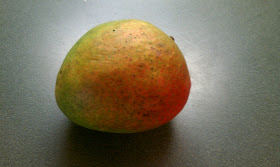Living in a small town like Owensboro can make purchasing of unusual fruits and vegetables a challenge. However, Owensboro grocery stores usually do have mangoes in stock. These are almost always the red/green skinned variety, very rarely do I see the yellow skinned type, which are by far superior when it comes to taste and sweetness. If you like mangoes, and you ever see the yellow ones, make sure to pick them up!! You'll be in for a real treat.
Mangoes are an exotic fruit around here, many people I meet in Owensboro have never even tried them before! (Poor souls.) If they have had them, they gave them either an 'eh, it was all right,' vote or a 'yuck!'. This is probably because A) they don't know how to pick good mangoes, and then B) don't know how to peel, slice and eat them. Don't have a bad mango experience! Here is my guide to make the most out of your local grocers mango selection!
Choosing mangoes:
1) Never eat a firm mango. They should be soft, with a slight wrinkling of the skin. This is when you know that the sweetness is at its highest. When the skin is removed, the flesh will be a vibrant orange and smell heavenly. The firm kind will be sour and crunchy, the flesh a white/light yellow color, the smell very slight if any scent at all. I always dig through the mangoes at the grocers, feeling for softness. If all my Krogers has is firm fruit, then I either don't buy, or I buy and then leave it out on the counter, waiting for softness. A mango doesn't always ripen properly on the counter, however, which is why I don't always buy if they are firm.
Slicing and Peeling Mangoes:
Never eat mango skin, it's bitter. There are two ways to peel and serve a mango that I know of:
1) I own a mango peeler, which makes this job very easy for me. Basically, it's a giant potato peeler, about three times the length. I bought it from importfoods.com for $11. Kinda pricey, I know, but I really like manoges, okay?
Here is what my mango looks like, after peeling. Use a knife to cut off the stem part.
2) If you don't have a fancy-pants mango peeler, like most normal people, then simply leave the skin on while cutting. Then, when sliced off, run a knife just under the skin to remove it. You will probably lose some flesh this way. Another option is to simply peel the skin off, like a banana. This method only works if the mango is ripe enough, and can be messy. If you want to make a presentation of your mango, don't use the peeling method, it will mangle it. If you just want to eat it however, go on ahead. It's easy!
When you hold a mango in your hand, you'll notice that it's flatter on two of its sides. This asymmetrical shape is caused by the seed inside, which is really hard and cannot be cut through, and makes slicing mangoes a pain if you don't know what your doing!
To make this easier, set your mango on the cutting board, narrow ends top and bottom. Then take your knife, making sure it's plenty sharp. Start slightly to the side of the top, slice down, and slide the knife along the seed. Should be very smooth and easy, if your mango is properly ripe. Once done, switch to the other side and do the same. This leaves some flesh still attached to the seed at the narrow ends. Take the knife and slide it along the seed at both ends, removing the remainder. (There will still be some flesh on the seed. I take this and chew on it like a hamster. No pictures available of chewed seed). Should look like this when done:
Now simply slice it up into smaller pieces, and enjoy!










